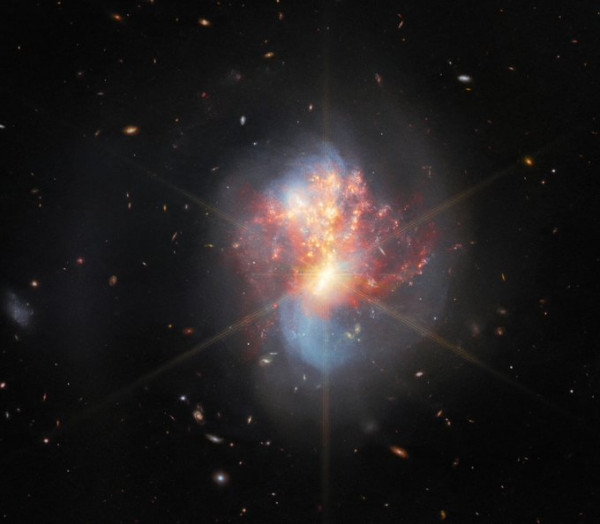of |
Khaled Younes |
Monday 31 October 2022 – 18:09
NASA’s James Webb Space Telescope has captured a stunning new image showing two colliding galaxies, triggering a star-forming wave invisible to other telescopes.
The star birth wave was created by the meeting of two galaxies known by the common name IC 1623, and scientists have claimed that the merging pair is producing stars at a speed 20 times faster than our own Milky Way.
This extraordinary event is known as a “galactic merger”, which creates a fascinating demonstration of star formation. These merging galaxies could be in the early stages of supermassive black hole formation.
The galactic collision was previously captured by other telescopes, including James Webb’s predecessor, the Hubble Space Telescope, which specializes in detecting optical light (the types of wavelengths visible to the human eye).
But because IC 1623 is shrouded in a thick dust shield, astronomers have not been able to dig deeper into galaxies to see star formation.
This is a remarkable achievement in astrophotography so early in the James Webb Space Telescope mission, as it was only launched in December last year.
The European Space Agency said: “A dense beam of dust has prevented this valuable information from the perspective of telescopes like Hubble. However, James Webb’s infrared sensitivity and impressive accuracy at those wavelengths allow him to see. beyond the dust, obtaining an extraordinary image.Two galaxies in IC 1623 are sinking into each other in a process known as “merging of galaxies”, according to “Russia Today”.
Read also:
IC 1623 is located about 274 million light-years away in the constellation of Cetus, which means that it took light about 270 million years to reach the James Webb Space Telescope. And so the state in which we see these galaxies is as it was all that time, and so we see past time through them.
This “galactic couple” was first discovered on November 19, 1897 by the American astronomer Louis Swift.
Also known as Arp 236, ESO 541-23 and IRAS 01053-1746, it consists of two irregular galaxies: IC 1623A and IC 1623B.
IC 1623 is extremely bright when viewed in infrared and has long been of interest to astronomers.
One of the two galaxies, the bright infrared galaxy, IC 1623B, contains a large amount of hot, dense gas. There is also a hot, dense gas in the interference region that connects the two nuclei.
The European Space Agency explained that “the intense continuous stellar explosion causes an intense emission of infrared radiation. The merging galaxies could be in the process of forming a supermassive black hole”.
Read also:
Read also:
A “fatal threat” .. Scientists warn of the risk of a merger between influenza and RSV

